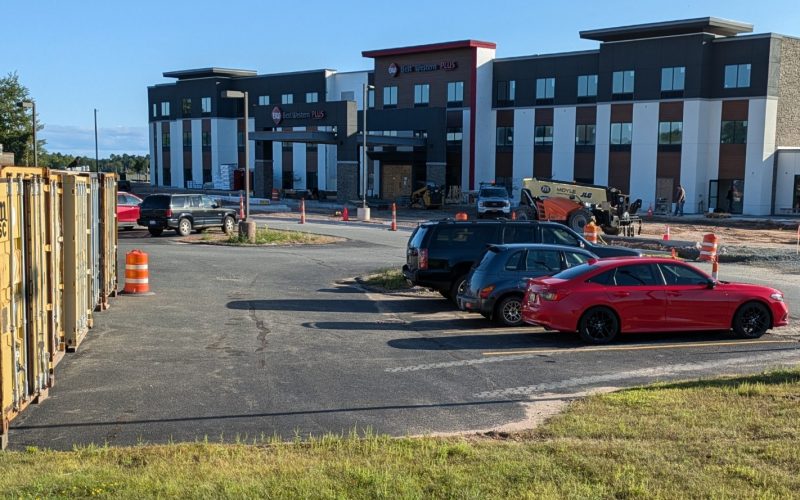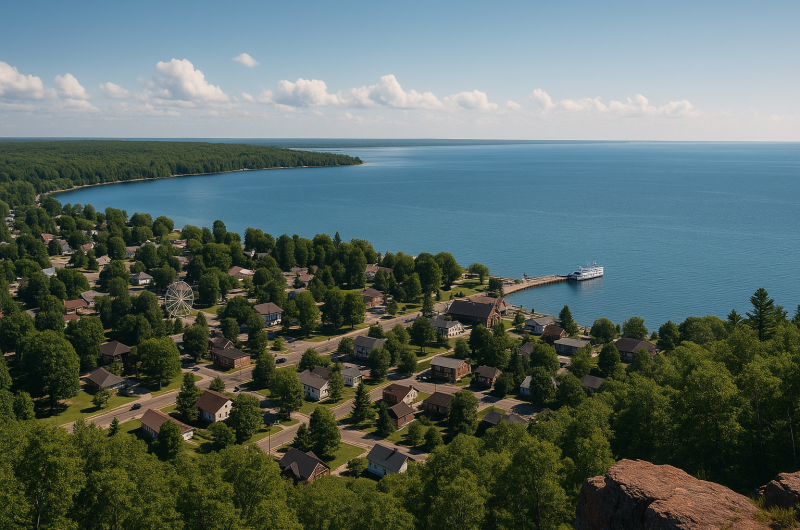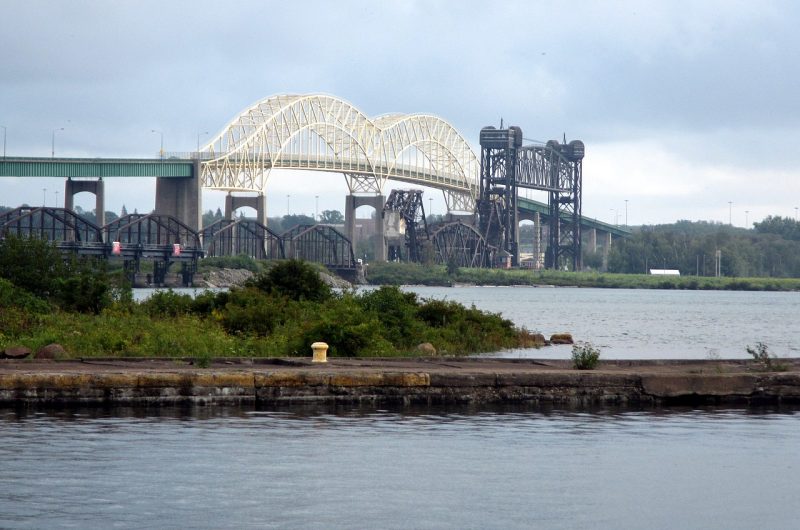The Upper Peninsula’s Tourist Economy

For over a hundred years the Upper Peninsula has been promoted as an escape from everyday life.
The Upper Peninsula Development Board, charged with diversifying the economy away from natural resources, published its first tourism leaflet in 1917, Cloverland in Clovertime: Touring through Picturesque Upper Peninsula Michigan, and targeted tourism markets in nearby metropolitan areas.
From the outset, the region has been marketed as offering an outdoors experience. After the end of the Second World War, the federal and state governments made major recreation investments in the U.P. including state parks, campgrounds, and additions to the National Park system.
With rising affluence and increased personal mobility, the numbers of visitors to the region soared. In 1958, the year after the Mackinac Bridge was constructed, approximately 1.3 million vehicles crossed the bridge; in 2023 the corresponding figure is 4.4 million, with the peak occurring during the summer months.
Tourism is an important contributor to the region’s economic well-being; according to data compiled by the Michigan Economic Development Corporation (MEDC) in 2022, it filled local and state coffers to the tune of $156 million in tax revenue. This article provides an overview of the region’s tourist economy, using data from the U.S. Department of Labor’s Bureau of Labor Statistics and MEDC.
Tourism Expenditures
Tourist spending in the region has grown over recent years, with the exception of 2020 when travel during the Covid pandemic was curtailed and spending shrank. In 2014, total tourist expenditures in the U.P. amounted to $1.2 billion; the corresponding figure in 2022 was $1.5 billion.
The largest expenditure component in 2022 was lodging ($461 million) followed by recreation ($309 million) which includes casino wagering, and food and beverages ($287 million). Mackinac ($280 million) and Marquette ($250 million) counties have the highest tourist expenditures, while Keweenaw County has the lowest ($23 million). Mackinac County is home to Mackinac Island, a major tourist destination, with an estimated 1.2 million visitors each year, mostly during the summer months.
Seasonality
A distinctive feature of the region’s tourist economy is its seasonality. The number of people employed in the hospitality and leisure sector varies at different times of the year, with over 4,000 more people employed in July than in February (Table 1).
Total employment peaks during the summer months for all counties, except for Gogebic County where winter tourism is the dominant season due to its importance as a skiing destination. The difference between summer and winter employment is most noticeable in Mackinac County, where almost 2000 more people are employed in July than in February.
This sharp difference explains the County’s July unemployment rate of 3.3 percent and February rate of 21.4 percent. A similar pattern is evident in Alger County with an unemployment rate of 10.9 percent in March and 4.6 percent in October. Some businesses have winter hours or shut down entirely during the off season, with small family-owned motels in non-skiing or snowmobiling areas often closing in early November and reopening the following spring.
Employment and Numbers of Business Establishments
The number of tourists visiting the region has steadily risen along with the number of employees in the hospitality sector (Table 2).
Total July employment increased by 549 between 2019 and 2023, with the largest absolute increase occurring in Alger County, home to Pictured Rocks National Lakeshore. In 2019, 859,000 people visited the park; two years later the figure was 1.3 million, with nearly 80 percent of arrivals concentrated in the June to September period.
And while their numbers helped boost tourist-related businesses in Munising, it meant that popular destinations within the park were overcrowded, resulting in damage to trails and roadsides. To deal with these issues and a backlog of neglected maintenance, the Park Service introduced a user fee in March 2022.
Since then, park attendance has fallen but still remains above its 2019 level. Despite the drop, the number of leisure and hospitality businesses in Alger County increased from 55 in 2019 to 68 in 2023 (Table 3).
Indeed, the U.P.’s total number of tourism related businesses increased by 170 between 2019 and 2023. Mackinac and Marquette counties, which are the region’s primary tourist destinations, experienced the largest gains.
Leisure and Hospitality Wages
Average weekly wages in the U.P.’s hospitality sector are higher during summer than winter, except in Iron County (Table 4).
Average industry wages, regardless of the season, are generally lower than the state average. Mackinac County is an anomaly, having significantly higher wages during the winter and summer. A comparison of wage levels during the peak summer months between 2019 and 2023 illustrates that despite the increase in the region’s tourist numbers, most counties continue to lag behind the state average.
Keweenaw, Chippewa and Alger all made significant gains during the period but still trail the state’s figure. Michigan’s 2023 minimum wage of $10.10 an hour means that for a person working 40 hours a week, they would make $404 which is above the average weekly wage of leisure and hospitality workers in most U.P. counties regardless of the season.
Indeed, average weekly wages for leisure and hospitality workers are significantly lower than for other service occupations. In Houghton County, for example, the third quarter average weekly wage for persons employed in services is $842, for leisure workers the equivalent figure is $357; for Dickinson County the comparable figures are $784 and $362 respectively.
Conclusions
The number of tourists visiting the Upper Peninsula continues to grow. To meet this growth, the number of businesses in the leisure and hospitality sector has increased. However, the seasonal variation in tourist numbers means that overall employment fluctuates to the tune of over 4,000 workers between the high and low seasons.
This highlights a problem with jobs in the hospitality sector: their seasonality. Furthermore, wages are relatively low compared with other service sector jobs. Yet, they may be the only source of local employment in some areas.
In short, tourism is important for the region but it is unrealistic to expect it to lift overall economic well-being.











Another well written article. Thank you.
Tourism is the worst part of the UP. I get that it’s money for people that live here and that job’s are hard to come by. But jobs aren’t more important than respecting the protections that Congress and state have put in place to protect the environment. Tourism is destroying the Rock River Wilderness Area. My property backs to the Rock River Wilderness Area. Private landowners and Alger County have created a de facto national park entrance at the Eben Ice Caves. It’s wilderness area in which I exercise my treaty rights to hunt, fish, gather and every year I pack out more and more trash from the canyon. USFS needs to shut it down. I’ve seen the caves backlit by commercial photographers with generators on facebook. Family members have reported snowmobilers in the canyon. And I see fewer and fewer deer. We need to balance tourism with protecting the land, lakes and the treaty rights of the UP’s original inhabitants.
I concur!
Without some type of regulation and oversight, this issue will only get worse.
Please attend the forest service meeting tonight at 5 PM at the rock River Township hall! Voices like yours need to be heard!
Very interesting read!
Tad
I spent Aug 19-23 up in the Copper Country/Keeweenaw, first time since 1976. It was truly an amazing visit. an interesting sidenote is I got this email newsletter today from a travel website….check out the first place to visit in the fall and avoid the crowds…
https://www.thediscoverer.com/blog/destinations-that-empty-out-in-the-fall/ZOVq4wU7rwAHX_dS?utm_source=blog&utm_medium=email&utm_campaign=2318431008
Interesting that Gogebic County has the 2nd highest weekly pay average after Mackinac. It would be interesting to see the data behind that. I wonder if the proliferation of cannabis outlets in Ironwood and cannabis tourism is a part of this? Although 2 new large Kwik Trips and a Marshalls store may have raised the weekly wage as well? Otherwise the winter weather depressed the tourism industry significantly there.
I’m curious about the Mackinac County unemployment figure of over 21%. I thought most of the seasonal workers are from foreign countries, here on H-2B work visas. Don’t they return to their home countries after high season? If so, why would they be included in MI unemployment rates? Or do they stay in the US? If so, are they eligible for unemployment?
Again, the writer, as he has a habit, recites a “bunch” of statistics and then provides his conclusion without getting into any discussion that supports his conclusion. For example, I was recently in a coffee shop in Munising and was served by a young man from Molvania. I learned that he and a fairly large group of young people from Eastern Europe were there to work for the summer. I further learned that this was necessary since there weren’t enough locals to do the work. This is also true in Mackinac County with a large number of summer workers from the Carribbean. How does this impact the writers conclusions regarding employment? Do you assume these workers would stay and live in the community?……they can’t. These persons should not be included in unemployment numbers. Further, since most workers in the service industry rely on tips which are significantly higher than paid wages, was this taken into consideration? In due respect, I don’t believe your conclusion is supported……there are many regions in the county where tourism “lifts up” the economy. It should be encouraged.